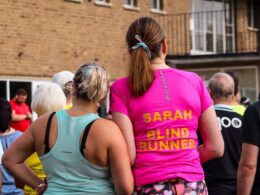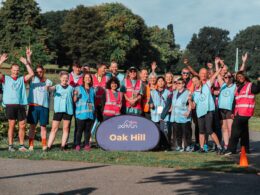‘Training’ should not be a word that puts you off: it’s not necessarily about going to the gym or joining an exercise class. In fact, it can really just be about actions you do every day of your life. And best of all, you can keep doing these things throughout your life, whatever your age or situation. We call this ‘stealth training’. Thankfully stealth training is easily incorporated into your daily routine. That is why we asked expert coaches Emma Kirk-Odunubi and Elle Linton to come up with exercises so stealthy, you can do them at home, or in public without anyone even knowing. In fact, whether it’s dashing for the bus or carrying that weekly shop, you might be doing some already…

The most important reason to do any exercises is simple: it helps with some of the most basic functions of daily life. Whether it’s getting up from the sofa, going confidently down the stairs or even just making fewer trips to the car when you are carrying in your weekly shop. Day-to-day tasks are easier if you’ve got good basic fitness, strength and balance. And that becomes more and more important as we get older, when reduced levels of muscle strength are associated with an increased risk of falling.
When it comes to strength exercises, the NHS recommends that, whatever our age, we do some a couple of times a week to target all the key major muscle groups. It’s good for you now and it’s an investment in your future – building strength can help keep you independent, healthy and mobile for longer.
Strength training is also particularly important for peri- and menopausal women, and for anyone who might be at risk of poor bone health. It helps build bone density, as well as muscle mass, which tends to decrease as we get older. It’s also really good for your joints, your metabolic health and helps you to recover from any injuries quicker. Strength training can also boost your mood – and if that weren’t enough, there’s even evidence it can help you live longer!
The great thing about these stealth exercises is it’s likely that you are actually doing them already, day in and day out – you’ve just never thought of them in that way. To take them to the next level, all you really need to do is make small changes to your daily routine. So next time you get up from that sofa, why not just try sitting back down again and doing it a few more times! Or you could try getting into the habit of balancing on one leg while you wait for the kettle to boil, or doing lunges when you brush your teeth.
These are simple ways to integrate key movements into your daily routine, without eating into your daily schedule. Now, why not see how many can you sneak into your day?
At home.
“We can build strength using the most everyday activity.” – EMMA KIRK-ODUNUBI.
Leg lifts:

This is an exercise that really targets the obliques, the muscles that run down the sides of your core. Take a seat on the edge of your bed or sofa, with your feet on the floor. Lean your upper body back from the hips. Keeping your knees bent, lift one leg off the ground, and hold for 10 seconds, while rotating your upper body discreetly in the opposite direction. Lower the leg back down to start position and repeat with the other leg.
Aim towards: Two sets of 20 each morning and/or evening.
Side leg raises:

When you have a few minutes spare – perhaps when you’re cleaning your teeth – stand with your feet shoulder-width apart, toes pointing forward. Then adjust your weight onto one leg and slowly lift the other leg straight out to the side. Pause, then slowly lower the leg back to the start position. Keep your hips even throughout the movement, repeating for the number of repetitions on each side.
Aim towards: One set of 8-12 repetitions on each side.
Calf stretches:
If you have stairs or even just one step – perhaps even a large book! – at home, then you can do this simple exercise to help strengthen your lower legs. Place the front of both of your feet on the step, with your heels hanging off the back. To stretch your main calf muscle, the gastrocnemius, keep your knee straight and drop your heel down, one leg at a time. If you bend your knee slightly as you drop your heel, you will target the smaller, bottom part of your calf, known as the soleus muscle.
Aim towards: Hold in this position for 20 to 30 seconds on each side.
On the street.
“Grocery shopping can be a full body strength exercise!” – ELLE LINTON.
Pump it up:

When you are moving around in everyday life, you can easily increase your speed as a stealth exercise to increase your heart rate. Simply walk a little faster, for a set distance or, if you can, start to jog a little. Pick a spot further down the road (for example to the next lamp post, or to the bus stop) and aim to get there faster than you would otherwise.
Aim towards: A minute or two of faster walking or a gentle jog.
Core grocery:

Who knew that grocery shopping can be a full body exercise which works everything from your shoulders, biceps, back and legs, to your core? Start by standing with your feet hip-width apart. Squat down – bending your knees not your back – and grab your bags in each hand. Engage your core, drawing your shoulders back and down, and drive your weight through your heels to come back into a nice upright position. Maintain this and focus on walking ‘tall.’
Aim towards: You can progress this exercise simply by carrying the shopping further. Ditch the shopping trolley and see if you can make it to the bus stop or to your car. You can also slow down to make it harder.
For a tougher progression, you can also try carrying shopping in one hand only, swapping occasionally, while making sure you don’t lean over to the side that the bags are on.
At work.
Calf raises:

Calf raises are a strength exercise for your lower legs and feet, that also help to strengthen the ligaments, improving ankle stability and mobility. You can do these unsupported – perhaps in an empty lift – or supported, holding onto a chair in the kitchen while you wait for the kettle to boil.
Start by standing with your feet shoulder-width apart, toes pointing forward. Relax your shoulders, keep a straight back and engage your core. Raise your heels slowly away from the ground, keeping a soft bend in your knees. Pause at the top, on your tiptoes, for 2 seconds, before slowly lowering the heels back to the ground.
Try for: 8-12 repetitions with 60-90 seconds rest, and repeat on both sides 2-3 times.
Foot doming:
This is an exercise you can even do in the middle of a meeting – and no one will ever know! It can really help build strength in the feet, which we often tend to neglect. You can do this seated or standing, ideally without shoes but it’s still beneficial with them.
Think about pushing into the floor with your foot whilst drawing the base of your big toe toward the back of your heel. This will engage all the muscles, tendons and ligaments situated underneath the foot.
Aim towards: Holding the tension you’ve created for 10-15 seconds, then repeating four or five times with a short rest between.
With the kids.
Balancing act:

Doing a single leg balance barefoot will help to strengthen your feet and ankles. Doing this exercise with your kids, as you brush your teeth together in the morning and evening, will improve the whole family’s balance.
Aim towards: As you brush your teeth for two minutes, morning and evening, spend one minute on one leg and one minute on the other. Start by having something to partially hold onto for safety









